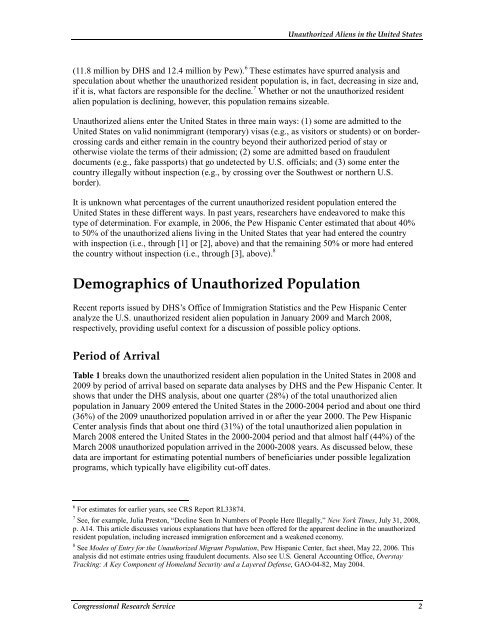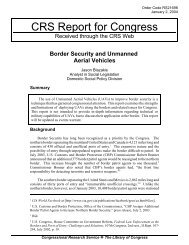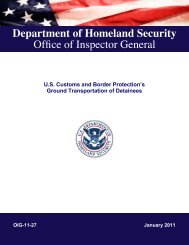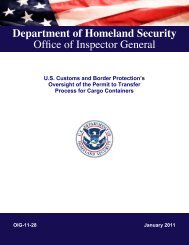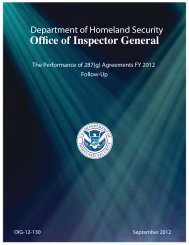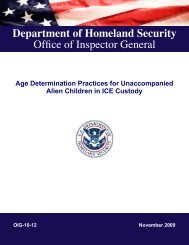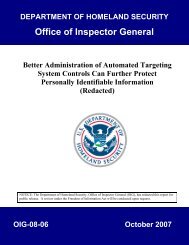Unauthorized Aliens in the United States - Federation of American ...
Unauthorized Aliens in the United States - Federation of American ...
Unauthorized Aliens in the United States - Federation of American ...
You also want an ePaper? Increase the reach of your titles
YUMPU automatically turns print PDFs into web optimized ePapers that Google loves.
<strong>Unauthorized</strong> <strong>Aliens</strong> <strong>in</strong> <strong>the</strong> <strong>United</strong> <strong>States</strong><br />
(11.8 million by DHS and 12.4 million by Pew). 6 These estimates have spurred analysis and<br />
speculation about whe<strong>the</strong>r <strong>the</strong> unauthorized resident population is, <strong>in</strong> fact, decreas<strong>in</strong>g <strong>in</strong> size and,<br />
if it is, what factors are responsible for <strong>the</strong> decl<strong>in</strong>e. 7 Whe<strong>the</strong>r or not <strong>the</strong> unauthorized resident<br />
alien population is decl<strong>in</strong><strong>in</strong>g, however, this population rema<strong>in</strong>s sizeable.<br />
<strong>Unauthorized</strong> aliens enter <strong>the</strong> <strong>United</strong> <strong>States</strong> <strong>in</strong> three ma<strong>in</strong> ways: (1) some are admitted to <strong>the</strong><br />
<strong>United</strong> <strong>States</strong> on valid nonimmigrant (temporary) visas (e.g., as visitors or students) or on bordercross<strong>in</strong>g<br />
cards and ei<strong>the</strong>r rema<strong>in</strong> <strong>in</strong> <strong>the</strong> country beyond <strong>the</strong>ir authorized period <strong>of</strong> stay or<br />
o<strong>the</strong>rwise violate <strong>the</strong> terms <strong>of</strong> <strong>the</strong>ir admission; (2) some are admitted based on fraudulent<br />
documents (e.g., fake passports) that go undetected by U.S. <strong>of</strong>ficials; and (3) some enter <strong>the</strong><br />
country illegally without <strong>in</strong>spection (e.g., by cross<strong>in</strong>g over <strong>the</strong> Southwest or nor<strong>the</strong>rn U.S.<br />
border).<br />
It is unknown what percentages <strong>of</strong> <strong>the</strong> current unauthorized resident population entered <strong>the</strong><br />
<strong>United</strong> <strong>States</strong> <strong>in</strong> <strong>the</strong>se different ways. In past years, researchers have endeavored to make this<br />
type <strong>of</strong> determ<strong>in</strong>ation. For example, <strong>in</strong> 2006, <strong>the</strong> Pew Hispanic Center estimated that about 40%<br />
to 50% <strong>of</strong> <strong>the</strong> unauthorized aliens liv<strong>in</strong>g <strong>in</strong> <strong>the</strong> <strong>United</strong> <strong>States</strong> that year had entered <strong>the</strong> country<br />
with <strong>in</strong>spection (i.e., through [1] or [2], above) and that <strong>the</strong> rema<strong>in</strong><strong>in</strong>g 50% or more had entered<br />
<strong>the</strong> country without <strong>in</strong>spection (i.e., through [3], above). 8<br />
Demographics <strong>of</strong> <strong>Unauthorized</strong> Population<br />
Recent reports issued by DHS’s Office <strong>of</strong> Immigration Statistics and <strong>the</strong> Pew Hispanic Center<br />
analyze <strong>the</strong> U.S. unauthorized resident alien population <strong>in</strong> January 2009 and March 2008,<br />
respectively, provid<strong>in</strong>g useful context for a discussion <strong>of</strong> possible policy options.<br />
Period <strong>of</strong> Arrival<br />
Table 1 breaks down <strong>the</strong> unauthorized resident alien population <strong>in</strong> <strong>the</strong> <strong>United</strong> <strong>States</strong> <strong>in</strong> 2008 and<br />
2009 by period <strong>of</strong> arrival based on separate data analyses by DHS and <strong>the</strong> Pew Hispanic Center. It<br />
shows that under <strong>the</strong> DHS analysis, about one quarter (28%) <strong>of</strong> <strong>the</strong> total unauthorized alien<br />
population <strong>in</strong> January 2009 entered <strong>the</strong> <strong>United</strong> <strong>States</strong> <strong>in</strong> <strong>the</strong> 2000-2004 period and about one third<br />
(36%) <strong>of</strong> <strong>the</strong> 2009 unauthorized population arrived <strong>in</strong> or after <strong>the</strong> year 2000. The Pew Hispanic<br />
Center analysis f<strong>in</strong>ds that about one third (31%) <strong>of</strong> <strong>the</strong> total unauthorized alien population <strong>in</strong><br />
March 2008 entered <strong>the</strong> <strong>United</strong> <strong>States</strong> <strong>in</strong> <strong>the</strong> 2000-2004 period and that almost half (44%) <strong>of</strong> <strong>the</strong><br />
March 2008 unauthorized population arrived <strong>in</strong> <strong>the</strong> 2000-2008 years. As discussed below, <strong>the</strong>se<br />
data are important for estimat<strong>in</strong>g potential numbers <strong>of</strong> beneficiaries under possible legalization<br />
programs, which typically have eligibility cut-<strong>of</strong>f dates.<br />
6 For estimates for earlier years, see CRS Report RL33874.<br />
7 See, for example, Julia Preston, “Decl<strong>in</strong>e Seen In Numbers <strong>of</strong> People Here Illegally,” New York Times, July 31, 2008,<br />
p. A14. This article discusses various explanations that have been <strong>of</strong>fered for <strong>the</strong> apparent decl<strong>in</strong>e <strong>in</strong> <strong>the</strong> unauthorized<br />
resident population, <strong>in</strong>clud<strong>in</strong>g <strong>in</strong>creased immigration enforcement and a weakened economy.<br />
8 See Modes <strong>of</strong> Entry for <strong>the</strong> <strong>Unauthorized</strong> Migrant Population, Pew Hispanic Center, fact sheet, May 22, 2006. This<br />
analysis did not estimate entries us<strong>in</strong>g fraudulent documents. Also see U.S. General Account<strong>in</strong>g Office, Overstay<br />
Track<strong>in</strong>g: A Key Component <strong>of</strong> Homeland Security and a Layered Defense, GAO-04-82, May 2004.<br />
Congressional Research Service 2


